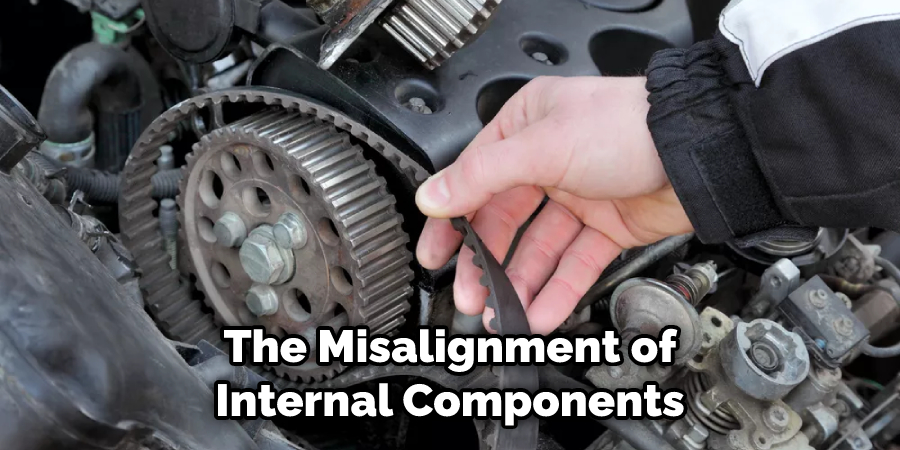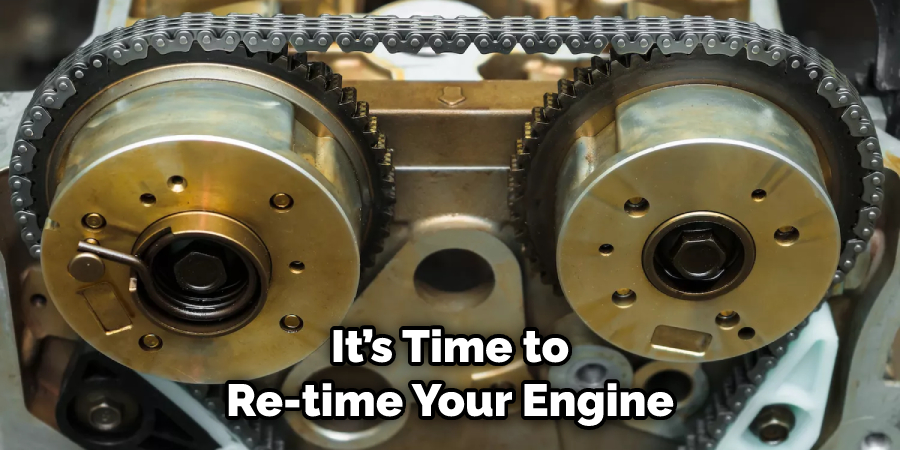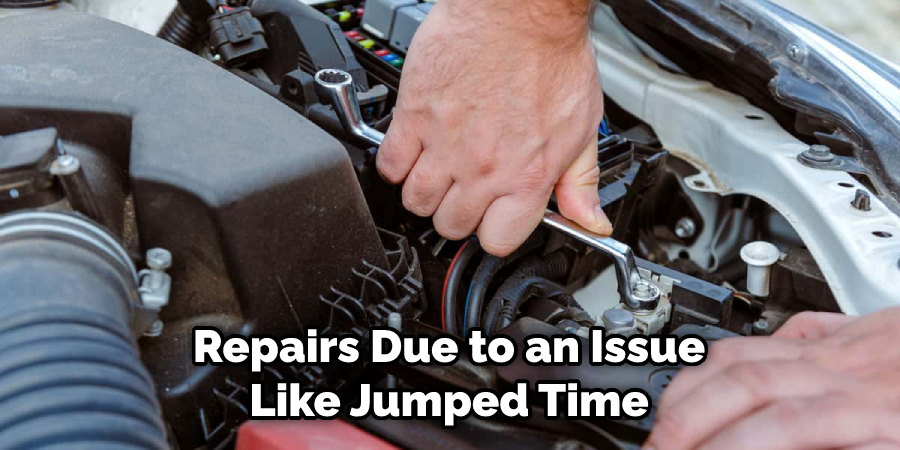Have you ever experienced the dreaded ‘jumped time’ in your car? It’s an incredibly frustrating experience, but fortunate for you, it is fixable! Before we get into the nitty-gritty of how to fix a car that jumped time, let’s first discuss what exactly jumped timing is and some common signs that can help you identify a potential issue.

Poor engine performance, strange knocking sounds coming from under the hood and if your Check Engine Light illuminates on the dashboard are all indicators of this condition.
Understanding more about this phenomenon will give you peace of mind when taking care of your car. So stay put as we explore what causes this issue and provide some easy tips on accurately diagnosing any related underlying problems with jump timing. Let’s get started!
Can you Fix a Car that Jumped Time?
Fixing a car that has jumped in time is possible, but it requires the help of a professional mechanic. When a vehicle experiences this issue, the gears and valves are out of alignment, which causes engine problems. To troubleshoot, the mechanic must carefully inspect all engine timing components, such as timing belts and pulleys.
Any damaged pieces need to be replaced in order for the timing to be set accurately. After replacing any faulty parts, they can then reset the valve and gear timing with a special tool. Then, your vehicle can run as smoothly as before with patience and precision.
Why Should you Fix a Car that Jumped Time?
If your car has jumped in time, you may wonder if it is worth taking the time and money to fix it. The answer is yes. Even though repairing a jump time issue can be costly, a healthy car means that you can save yourself additional costs down the road.
By addressing this issue, you can prevent more mechanical problems from occurring due to the misalignment of internal components caused by a jumped timing belt or chain. Ultimately, investing in repairs now could help keep you on the road longer and with fewer auto issues.

7 Steps to Follow on How to Fix a Car that Jumped Time
Step One: Diagnose the Problem
The first step in fixing any car problem is properly diagnosing the issue. In this case, you need to figure out what caused the time jumping and address it directly. To start, check for signs of damage on your timing belt or chain and look for broken valves or pistons if you have an interference engine.
You should also examine other engine components, such as spark plugs and fuel injectors, to check if they are functioning correctly. Once you identify the source of the problem, you can move on to step two.
Step Two: Replace Any Broken Components
If any components in your engine were damaged due to the time-jumping event, it is important that they are replaced as soon as possible. Doing so will ensure that your engine runs smoothly and efficiently without any further issues.
Depending on your vehicle type and what damage occurred, you may need to take your car to a mechanic for repairs. If not, then simply purchase replacement parts from an auto parts store and install them yourself, following any instructions provided by the manufacturer’s manual or online tutorials from experienced mechanics.
Step Three: Adjust Your Timing Belt or Chain
Once all necessary repairs have been made and all new components have been installed correctly, it’s time to adjust your timing belt/chain back into its correct position.
To do this, use a dial indicator tool or a similar device to measure small distances with high accuracy. Make sure that everything lines up properly before moving on; otherwise, you could end up with further problems down the line!
Step Four: Re-Time Your Engine
Once the belt/chain is properly adjusted, it’s time to re-time your engine. This can be done via a timing light or by using a mechanical timing device such as a degree wheel. Again, accuracy is key here, so take your time and ensure everything lines up correctly before continuing.

Step Five: Replace Oil, Air, and Fuel Filters
After re-timing your engine, it’s important to replace any worn-out oil, air, or fuel filters, as these can contribute to poor efficiency and performance if left unchanged.
Again, how exactly you go about this depends on your make and model of car, but it usually involves unscrewing the filter cover and replacing the old filter with a freshly bought one.
Step Six: Re-Assemble Engine Parts
The next step is to reassemble all the parts that were taken apart during the repair process. Ensure everything fits correctly and screws are tightened properly to avoid further damage! It may also be necessary to add new oil or other fluids; consult your owner’s manual for instructions.
Step Seven: Test Your Car
The final step is to test your car and ensure everything runs smoothly and as expected. Next, start the engine and let it idle for a few minutes, then take it out on a short drive around the block to check how the car responds. If you encounter any further issues, don’t hesitate to contact a professional mechanic for assistance.
That’s it! You’ve now learned how to fix a car that jumped time. But remember, if you ever need further assistance, it’s always best to contact a professional for help!
Things You Need to Know Before Fixing a Car that Jumped Time
Fixing a car that has jumped time is not for the faint of heart and requires equal parts mechanical know-how and perseverance. Therefore, before starting this task, it’s important to familiarize yourself with the engine type and its components, making sure to have the necessary tools available.
In order to help diagnose the cause, you’ll need to review how timing belts operate and understand any indicators of belt malfunction. Without doing your due diligence first and gathering all the necessary resources, you may be unable to complete the project or cause more damage than you initially began with.
While jumping time can be daunting — don’t lose hope! With enough knowledge, careful attention, and effort, you can regain your vehicle in fighting shape in no time.
Benefits of Fixing a Car that Jumped Time
Keeping a car in good repair is important for its longevity, and occasionally a vehicle may require special repairs due to an issue like jumped time. If you find yourself in this predicament, it pays to know the benefits of fixing it yourself — or at least having them fixed by a professional.
Putting the initial effort into resolving problems from jumped time keeps your car running more efficiently and makes it safer for you and other drivers on the road.

The cost savings from taking care of this quickly can be significant, too; catching the issue early saves you money long-term, as any potential collateral damage can be avoided. Ultimately, taking the initiative to repair a car that has jumped time is an investment worth making.
5 Common Mistakes People Make When Trying to Fixing a Car that Jumped Time
1. Not Checking the Oil Level
One of the most common mistakes people make when their car has jumped time is not checking the oil level. The oil lubricates the engine and helps keep it running smoothly. If the oil level is low, it can cause the engine to seize up, which can be expensive to fix.
2. Not Checking the Tire Pressure
Another common mistake people make is not checking the tire pressure. If the tires are not properly inflated, it can cause them to wear out prematurely. Additionally, it can also lead to a blowout, which can be dangerous.
3. Not Changing the Spark Plugs
Spark plugs are what ignite the fuel in the engine, and over time they can become fouled or worn out. If they are not changed on a regular basis, it can lead to engine problems. Additionally, it can also make the car less fuel-efficient.
4. Not Checking the Coolant Level
The coolant helps to keep the engine cool and prevents it from overheating. If the coolant level is low, it can cause the engine to overheat, which can damage vital components. Additionally, if the engine overheats, it can lead to a fire.

5. Not Checking for Leaks
Leaks are another common problem that people often overlook when trying to fix their cars. Leaks can occur in various car parts, such as radiators, hoses, or gaskets. If left unchecked, leaks can cause serious damage to the car and may even render it undrivable
Conclusion
Fixing a car that has jumped time can be complex but is not impossible with proper knowledge and care are taken during each process step.
With patience and dedication, anyone can repair their vehicle themselves or take it to a professional mechanic for assistance if needed – either way, it’s important to remember that safety always comes first when dealing with automotive repairs!
Remember these steps next time your car jumps time so you can get back on the road quickly without further complications! Thanks for reading our post about how to fix a car that jumped time.
You Can Check It Out to Repair Wall After Removing Wainscoting
